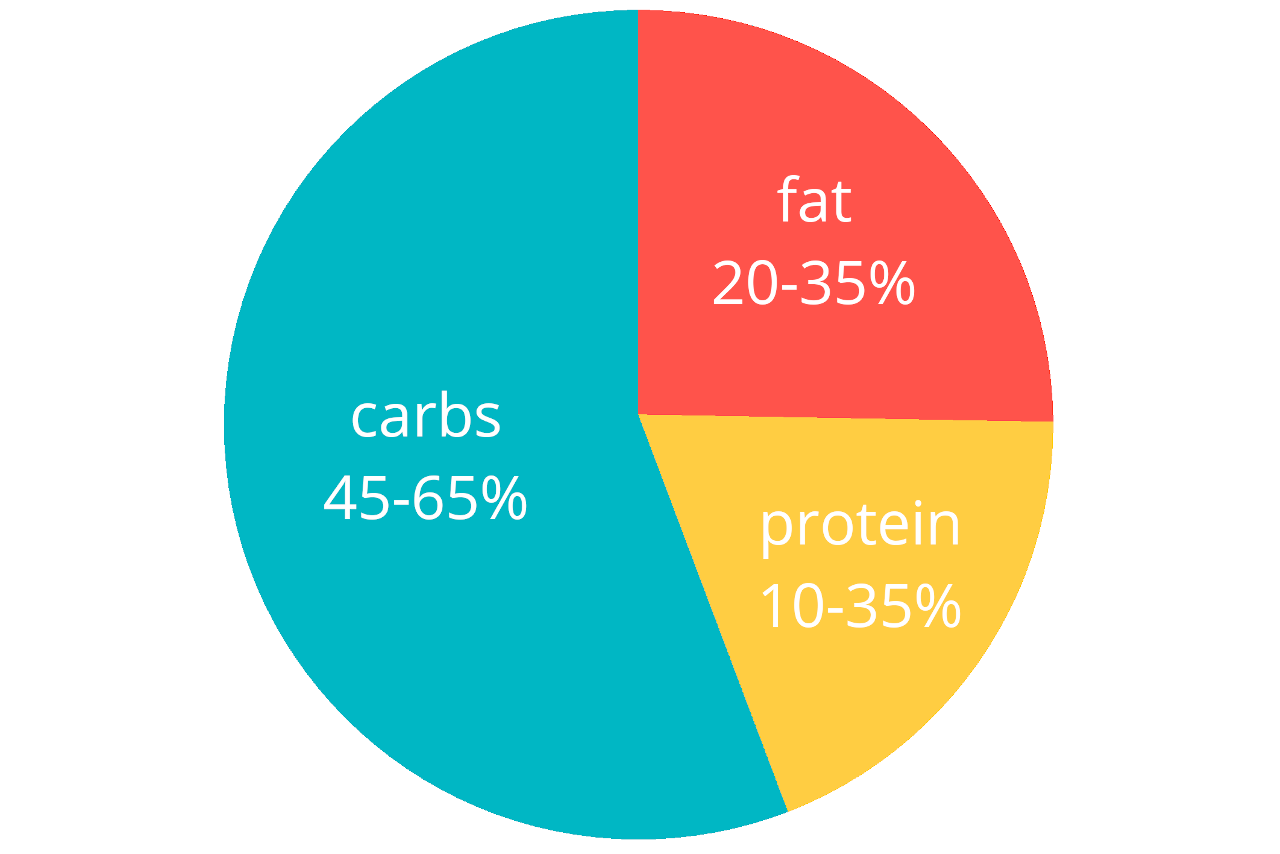Carb Calculator – Calculate Carbohydrate Intake
Enter your age, height, weight, activity level, and nutrition goals to calculate how many carbs you should eat.
On this page:
How Many Carbs Should You Eat
Carbohydrates are the prime energy source that your body uses to perform everyday activities. The amount of carbohydrates that your body requires will depend on the amount and type of activity you engage in daily.
Sedentary individuals require fewer overall calories, and thus have lower carbohydrate needs than athletes.
The National Academy of Sciences and the Dietary Guidelines for Americans 2020-2025 recommends that 45-65% of your total daily calorie intake should come from carbohydrates.[2]

Energy and macronutrient needs, especially carbohydrates and protein, must be met during times of high physical activity to fuel activity and replenish glycogen stores.
Therefore, carbohydrate recommendations for athletes tend to be a bit higher and range from 6 to 10 g/kg (2.7 to 4.5 g/lb) body weight per day, according to position statements from The American Dietetic Association, Dietitians of Canada, and the American College of Sports Medicine: Nutrition and Athletic Performance.[4]
Diets such as keto focus heavily on reducing carb intake and accounting for dietary fiber and sugar alcohol to focus more on net carbs.
How to Calculate Carbohydrate Intake
Since the amount of carbohydrates you should consume depends on your total daily calorie needs, you first need to calculate your total daily energy expenditure (TDEE). This is based on your basal metabolic rate (BMR) multiplied by an activity factor based on how active you are on a daily basis.
Once you calculate the total number of calories you should eat each day, the next step is to determine how much of those calories should come from each macronutrient food group: carbohydrates, protein, and fat.
Breaking down your calorie count into macronutrients is more commonly known as “counting macros.” This is a useful way to make sure you’re consuming the right proportions of carbs, protein, and fat.
Each of these macronutrients (carbs, protein, and fat) makes up a percentage of your total calories. The amount of each macronutrient that you should include in your diet depends on your current weight and fitness goals.
| Goal | Protein | Carbohydrate | Fat |
|---|---|---|---|
| General Fitness | 10-15% | 45-55% | 25-35% |
| Medium to High Intensity Fitness (1-2 hours/day, 4-6 days/week) |
20-30% | 55-65% | 30% |
| Weight Loss | 25-30% | 45-50% | 20-25% |
By taking your daily calorie requirements and multiplying this by the desired carbohydrate percentage, you can find how many calories you should consume from carbs each day.
Next, you will convert the amount of calories from carbohydrates into grams of carbohydrates. Each macronutrient provides a certain amount of calories per gram.
- 1 gram of protein = 4 calories
- 1 gram of carbohydrate = 4 calories
- 1 gram of fat = 9 calories
So, to convert calories of carbohydrates to grams, divide calories from carbs by 4. This is an estimate of how many grams of carbs you should consume on a daily basis.
If you are an athlete or involved in a high level of physical activity, you will require more carbohydrates to fuel your sports. You can use the higher percentage noted in the table above to calculate your carbohydrate needs.
Another method is to calculate your carbohydrate needs based on your weight. The recommendation for athletes is to consume 6-10 grams per kilogram of carbohydrates.
Weight Loss
Counting macros can be an effective method to aid in weight loss. Determining the amount of carbohydrates you should eat daily should be based on your calorie requirements for safe weight loss.
One method for doing this is to calculate how many calories you should eat (essentially your TDEE), and subtract 500 calories from this. This will give you a calorie deficit that is not too extreme, but can still result in weight loss if consistently maintained.
You can also calculate your total calories burned by adding up your daily activities and using the MET calculator for each activity.
The amount of carbs you should eat is based on a percentage of the calories you burn that day, which will typically range from 45-65%, depending on your current fitness goals.
This will also allow you to see if you are burning the same, less, or more calories than you expend each day if you compare your calories burned daily to your total daily energy expenditure.
Good Carbs Vs. Bad Carbs
Once you calculate how many carbs you should eat daily, it is important to determine what types of carbohydrates you should consume. While there really isn’t a “good” or “bad” list of food, there are definitely better carbohydrate options than others when it comes to following a healthy diet.
Good Carbs
Good carbs include complex carbohydrates and high-fiber foods. These are foods that are absorbed and metabolized more slowly and won’t spike your blood sugar and insulin levels. These include foods like whole-grain breads, oatmeal, beans, and starchy vegetables.

These foods are high in fiber and can also help lower cholesterol and maintain healthy blood sugar levels. Since they are digested more slowly, they will also make you feel fuller for longer, which will help you avoid overeating.
Bad Carbs
It’s important to limit the amount of simple carbs that you consume. Foods made with added sugars, like processed pastries, candies, or anything with high fructose corn syrup, will quickly raise your blood sugar and can lead to unhealthy spikes in insulin.

In addition, these foods often are just “empty calories” and lack vitamins, minerals, and fiber. Because these foods cause rapid blood sugar fluctuations, this can lead to tiredness and irritability. On top of this, high-sugar foods often cause you to overeat and are associated with weight gain.
Excess calorie intake from sugary foods has been associated with obesity, diabetes, and heart disease.[6] The Dietary Guidelines for Americans 2020-2025 report suggests limiting calories from added sugars to less than 10 percent of total calories per day.[7]
While it was not included in the final report, the 2020 Dietary Guidelines Advisory Committee revisited this topic and found that a more appropriate target to help decrease cardiovascular disease and obesity is to lower the amount of sugar consumption down to 6% of total calories.[8]
By determining your carbohydrate needs and then choosing healthy food options, you are likely to maintain a healthy weight and lifestyle.
Similar Nutrition Calculators
References
- Institute of Medicine of the National Academies, Dietary Reference Intakes - The Essential Guide to Nutrient Requirements, https://nap.nationalacademies.org/read/11537/chapter/1
- U.S. Department of Agriculture, Dietary Guidelines for Americans 2020-2025, https://www.dietaryguidelines.gov/sites/default/files/2021-03/Dietary_Guidelines_for_Americans-2020-2025.pdf
- Academy of Nutrition and Dietetics, Position of the American Dietetic Association, Dietitians of Canada, and the American College of Sports Medicine: Nutrition and Athletic Performance, https://www.andeal.org/vault/2440/web/200903_NAP_JADA-PositionPaper.pdf
- Rodriguez, N. R., DiMarco, N. M., & Langley, S., Position of the American Dietetic Association, Dietitians of Canada, and the American College of Sports Medicine: Nutrition and athletic performance, Journal of the American Dietetic Association, 2009, 109(3), 509-527. https://www.jandonline.org/article/S0002-8223(09)00006-6/fulltext
- Bachus, T., How to Determine the Best Macronutrient Ratio for Your Goals, American Council on Exercise, 2016, April 15, https://www.acefitness.org/resources/pros/expert-articles/5904/how-to-determine-the-best-macronutrient-ratio-for-your-goals/
- Johnson, R. K., Appel, L. J., Brands, M., Howard, B. V., Lefevre, M., Lustig, R. H., Sacks, F., Steffen, L., & Wylie-Rosett, J., Dietary sugars intake and cardiovascular health: a scientific statement from the American Heart Association, Circulation, 2009, 120(11), 1011-1020. https://www.ahajournals.org/doi/full/10.1161/CIRCULATIONAHA.109.192627
- Phillips, J. A., Dietary Guidelines for Americans, 2020–2025, Workplace Health & Safety, 2021, 69(8), 395. https://doi.org/10.1177/21650799211026980
- Dietary Guidelines Advisory Committee, Scientific Report of the 2020 Dietary Guidelines Advisory Committee: Advisory Report to the Secretary of Agriculture and the Secretary of Health and Human Services, U.S. Department of Agriculture, Agricultural Research Service, Washington, DC, 2020, https://www.dietaryguidelines.gov/sites/default/files/2020-07/ScientificReport_of_the_2020DietaryGuidelinesAdvisoryCommittee_first-print.pdf



